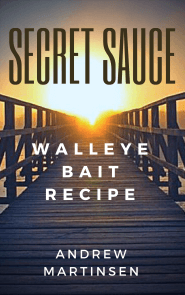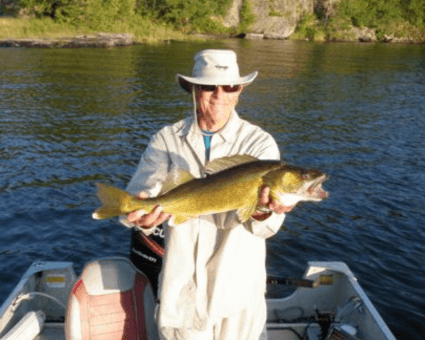Sign up for FREE Walleye Fishing Tips
• Sign up for a Complimentary Copy of
My Report Called "Secret Sauce: The Bait Recipe for More and Bigger Walleyes."

• PLUS, you also get a complimentary subscription to my exclusive email publication, jam-packed with loads of "under-the-radar"
walleye fishing tips that can help you to catch walleyes fast!

Privacy Guarantee: I solemnly pledge never to spam you or sell your email address to anyone, and of course you can unsubscribe at any time.
Contour Trolling
|
Fishfinder Tips
|
Jigging Tips
|
Crankbait Tips
|
Trophy Walleyes
|
More Reports...

Andrew Martinsen's Walleye Fishing Update
Migration Madness
How to Use the Walleye's Natural Migration Patterns to Your Advantage
Hey, it's Andrew Martinsen. The simple fact is, when you know where walleye like to hang out you can catch more of them.
And when you know WHY they're going where they're going, then you've put yourself in position
to turbocharge your fishing.
Without knowing the water and the habits of the
Walleye in that specific water, whether it is a lake,
stream, river, reservoir or other body of water or a river,
you can not be as successful or get results which are
as good.
Almost every state in America has lakes and other waters which contain a large population of Walleye, and this fish species is one of the most frequently fished. Walleye can be fished during all seasons and all year round, including ice fishing in the northern states during winter. Knowing the travel paths and migration patterns can be immensely helpful in locating this fish, because their movements and habits change according to the weather.
During the course of a twenty four hour period, Walleye will move from shallower water to deeper water, and follow certain paths around areas of the lake. When the water is warmer, usually during the day and the in summer months, these fish generally head for deeper waters in the lake, because these waters are cooler and allow less light in. At night the fish may come into shallow water to feed, heading back out to lower depths after done. Walleye generally stay at the same depth when swimming around the lake, and over time they develop a specific route that is traveled. These fish usually will not swim across wide open lake areas that are not part of their specific traveling path. Walleye will generally prefer to stay in waters that are choppy, not calm. If the lake is clear the fish will stay in areas that are murky with algae or suspended silt, or areas with windy conditions which create small surface waves.
Walleye are very sensitive to water temperature, and they prefer water that is below seventy five degrees. This is why they stay in deep water most of the time.
The exception to this is during the spawning season, when they move into waters which are shallow. Approximately one or two weeks before spawning begins, the Walleye will swim into shallow water after dark, because this is where the spawning grounds are. Just before the sun comes up, the fish move back out to the deeper waters, and this pattern is followed daily until the spawning is complete. The males will continue this pattern for as long as a month after the spawning is complete, staying near the spawning area, while females leave the area as soon as the spawning is done. Ideal spawning areas include shorelines which are rocky and shallow, as well as reefs. The water in these areas can be as shallow as two feet, making them ideal for egg laying.
Walleye travel and migration patterns follow predictable patterns that can greatly improve your fishing results, if you know these patterns. The fish prefer to follow cold water currents and choppy water conditions, through the course of the day and the year. In the spring and summer months the Walleye move into water that is not as deep as their winter areas, but unless they are spawning the fish generally prefer deeper water which is cooler over shallow warm water. During the day Walleye prefer underwater structures like islands and deep weed beds where the sunlight can not easily reach. At night these areas are used by the fish because of the abundance of food sources available.
Have fun fishing!,
Andrew Martinsen
You're About to Discover Intense Walleye Fishing Techniques that Can Increase Your Walleye Catch Count When You Hit the Water
Inside My Exclusive Email Publication, You'll Discover...
• An underground Secret Sauce bait recipe for catching walleye.
• Under-the-radar walleye fishing tips that can help you to catch walleyes fast!
• How to create an irresistible attraction to
your offering that can make even satisfied fish that aren't hungry snap at it.
• How to catch more and bigger walleyes using the stuff you've already got in your tackle box.
• And much, much more!

Directions: It's easy. Simply fill in
your name and email address and your first of many FREE
underground walleye
fishing reports will be sent to your email box immediately. Go ahead right now...

"Andrew,

25 Inch Walleye Caught at Lake of the Woods
Walleye Fishing Secrets Student Shares an Awesome Catch

Here's a 25 inch walleye caught at Lake of the Woods, Ontario. The
picture is a great memento for me.
I caught it drifting. We caught it amongst some smaller ones that ended up
on the dinner table.
Your advice was helpful in making my trip successful. Thank you!"
- Russell K.
Join thousands of anglers throughout North America who are catching more and bigger walleyes from shore or on a boat in lakes, rivers and streams:
Join thousands of anglers throughout North America who are catching more and bigger walleyes from shore or on a boat in lakes, rivers and streams:

If you've been wanting to get more satisfaction from your
walleye fishing outings, sign up to my
FREE
walleye fishing catching email publication!
Great Fishin' to You! (Always),
Sincerely,
Andrew Martinsen
WalleyeFishingSecrets.com
WalleyeFishingSecrets.com


